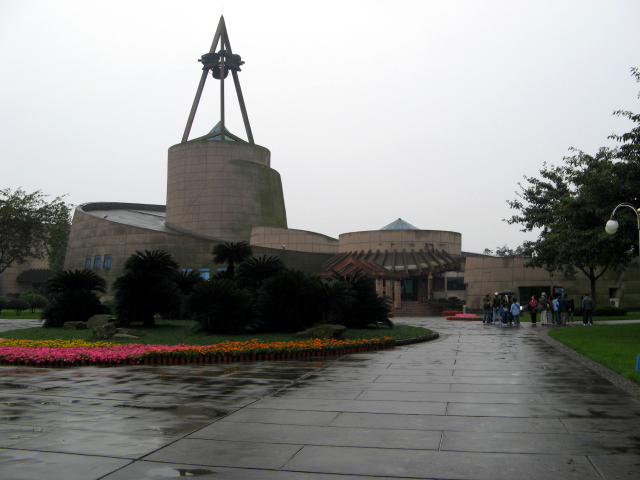
Sanxingdui Museum
24km (15mi) north of Chengdu

|
Sanxingdui Museum24km (15mi) north of Chengdu |
The discoveries at Sanxingdui, in the late 1980s, confronted archaeologists with an enigma: a material culture, datable roughly to the Shang Dynasty of 1500-1000 BC, that seemed, as Robert L. Thorp put it, "to represent an alternative early Bronze Age culture within modern-day China, a tradition quite foreign to the expectations of conventional wisdom." (Thorp, Visiting China's Past, p. 81.)
The most obvious difference, between Sanxingdui and the Chinese Bronze Age cultures of Henan, is the presence at Sanxingdui of a figural bronze tradition – statues, heads, and faces – without precedent elsewhere in China. The Sanxingdui artifacts had been ritually broken, burned, and carefully buried in two large pits within the ancient walled town. This is a typical way of decommissioning sacred objects, and no doubt that is what was going on here. They are often called "sacrificial" pits, although they were not associated with human remains. The pits were dated, by stratigraphic and stylistic analysis, to around 1200 BC. Pit 1 is a few decades earlier than Pit 2, which implies that there were two separate acts of decommissioning, performed a generation or so apart, at the site.
Who were the Sanxingdui figures? Did they represent gods, ancestors, rulers, priests, or something else entirely? This question, like so many about Sanxingdui, remains unanswered, due both to a lack of written evidence (no inscriptions were found), and to a lack of relevant context; at present (2007), we simply do not know what these figures meant to the people who made them. Archaeologists have recently uncovered other sites, at Jinsha and elsewhere, that belong to the Sanxingdui culture; no doubt these, and other discoveries yet to come, will greatly increase our knowledge in the future.
The following pages present a selection of finds that are currently displayed in the museum: (1) a large, standing bronze figure; (2) other figural bronzes (heads and faces), some with gold masks; (3) several tall and elaborate bronze trees; and (4) a sample of other artifacts. Readers should keep in mind that interpretation of these objects is, at this stage, largely conjectural. For more information about Sanxingdui, see: Robert Bagley (ed.), Ancient Sichuan: Treasures from a Lost Civilization, the catalogue of the museum's recent international exhibition. A full bibliography can be found in the catalogue.

|

|